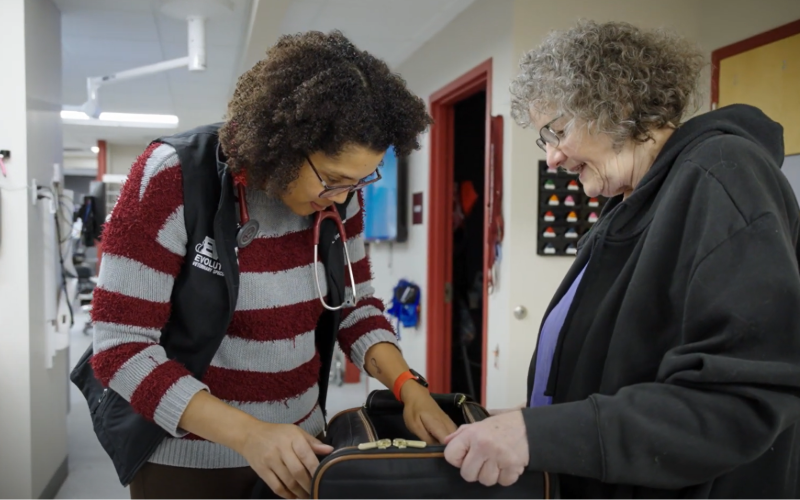The Function of Ultrasound and CT Check in Modern Veterinary Practices: Insights From Experienced Professionals
In contemporary vet practices, ultrasound and CT scans significantly improve diagnostic capabilities. These imaging strategies offer crucial insights right into animal health and wellness, directing treatment decisions. Experienced professionals identify the unique benefits of each technique. Ultrasound provides real-time analyses, while CT scans provide detailed physiological details. Comprehending their applications and functions increases essential inquiries concerning their impact on individual end results and the future of veterinary diagnostics. What insights can be acquired from their incorporated use?
Understanding Ultrasound in Vet Medication
Ultrasound is an essential analysis tool in vet medicine, using a non-invasive approach to picture interior frameworks. This imaging strategy uses high-frequency sound waves to create real-time images of cells and organs, permitting vets to examine problems without medical intervention. Typical applications consist of assessing the heart, liver, kidneys, and reproductive organs, in addition to checking pregnancies.The treatment is fairly quick and can be executed in various settings, making it an obtainable alternative for vets. Unlike radiography, ultrasound gives detailed information concerning soft tissues and blood circulation, which is crucial for precise diagnoses.Veterinary experts count on ultrasound to spot problems such as growths, cysts, and liquid accumulation. Its capability to direct biopsies and various other procedures further enhances its utility in clinical method. By offering a reliable and risk-free means to check out internal anatomy, ultrasound has ended up being a foundation of modern-day vet diagnostics.
The Advantages of CT Checks for Pet Diagnostics
CT scans offer significant benefits in vet diagnostics by providing boosted precision in determining interior problems (CT Scans For Animals). As a non-invasive imaging technique, they ensure the safety and convenience of animals during evaluations. On top of that, CT checks help with a complete evaluation of inner frameworks, allowing for a lot more reliable therapy preparation
Boosted Analysis Accuracy
Advancements in imaging technology have greatly enhanced analysis accuracy in veterinary medicine, especially through the usage of CT scans. These scans supply detailed cross-sectional pictures of an animal's interior structures, allowing vets to recognize abnormalities with precision. The high resolution and three-dimensional capabilities of CT imaging help with the discovery of conditions such as growths, cracks, and inner blood loss that could be missed out on with traditional imaging techniques. Furthermore, CT scans can assist in pre-surgical planning by providing a thorough sight of physiological connections. This degree of information not just improves the precision of diagnoses but also help in customizing reliable treatment plans. Consequently, the assimilation of CT innovation into vet methods is transforming the landscape of pet medical care, boosting end results for clients.
Non-Invasive Imaging Strategy
The intro of non-invasive imaging methods has actually transformed pet diagnostics, with CT checks becoming a famous tool in vet methods. These scans offer high-resolution, cross-sectional pictures of a pet's inner frameworks, enabling vets to examine complex conditions without the demand for intrusive procedures. The benefits of CT scans include their ability to find growths, cracks, and inner bleeding with exceptional accuracy. Additionally, they assist in the examination of soft cells and body organs, boosting diagnostic capabilities. The speed of CT scanning allows quick decision-making, which is crucial in emergency situation scenarios. By reducing stress and anxiety and pain for the animal, CT scans add to a more gentle technique to diagnostics, eventually improving therapy results and advancing vet care.
Comprehensive Internal Evaluation
A detailed interior analysis is crucial for precise diagnosis and efficient therapy in veterinary medicine. CT scans offer substantial advantages hereof, giving thorough cross-sectional photos of an animal's inner frameworks. This sophisticated imaging technique improves visualization of complicated physiological areas, allowing vets to determine abnormalities such as tumors, cracks, and inner blood loss with higher accuracy. Furthermore, CT scans help with the assessment of conditions that may be testing to identify with standard approaches. The rate and accuracy of CT imaging also add to timely interventions, boosting patient results. As vet techniques progressively incorporate CT technology, the benefits of considerable internal analyses come to be noticeable, enhancing the value of this tool in modern vet diagnostics.
Contrasting Ultrasound and CT Imaging Techniques
While both ultrasound and CT imaging offer essential roles in veterinary diagnostics, each method uses unique benefits and constraints that can affect professional decision-making. Ultrasound is particularly valued for its real-time imaging capacities, allowing vets to observe vibrant physiological processes. This strategy is non-invasive, portable, and does not involve ionizing radiation, making it a safer option for both pets and clinicians. However, ultrasound might have constraints in picturing specific anatomical frameworks or deep tissues.Conversely, CT imaging provides thorough cross-sectional views of the body, permitting accurate localization of abnormalities. It masters assessing complicated organs and frameworks, especially in the thorax and abdominal area. Nonetheless, CT scans require sedation or anesthesia in a lot of cases and include exposure to ionizing radiation. Eventually, the choice in between ultrasound and CT relies on the particular medical situation, the location of rate of interest, and the seriousness of the diagnostic needs.
Instance Studies: Effective Diagnoses Via Imaging
Study highlight the substantial enhancements in analysis precision accomplished through advanced imaging modern technologies like ultrasound and CT scans in vet methods. These innovations not only enhance the detection of various conditions yet likewise help with effective and prompt treatment strategies. Assessing certain instances can highlight the transformative influence of these imaging techniques on veterinary medicine.
Diagnostic Precision Improvements

Imaging Technology Advancements
As vet imaging technology proceeds to advance, its effect on click to read more diagnostic capabilities becomes significantly evident. Current case researches highlight the successful application of sophisticated ultrasound and CT scan techniques in determining complicated conditions. A veterinary clinic utilized high-resolution CT scans to identify a rare kind of lung cancer in a canine, which standard imaging had actually missed out on. An ultrasound examination disclosed an abdominal mass in a feline, prompting prompt medical intervention and a favorable outcome. These improvements not only improve diagnostic accuracy however likewise enable vets to devise targeted treatment plans. By leveraging sophisticated imaging technologies, vet professionals are significantly boosting individual care, bring about much more reliable management of different health and wellness conditions in pets.
The Function of Imaging in Emergency Veterinary Treatment
Imaging plays a crucial role in emergency situation veterinary treatment, giving veterinarians with crucial info needed to make rapid, informed choices. In immediate scenarios, techniques like ultrasound and CT scans make it possible for experts to quickly examine a family pet's internal structures, recognizing vital problems such as inner bleeding, cracks, or body organ problems. These imaging methods enable real-time analyses, assisting in timely treatments that can be life-saving. Ultrasound is vital for assessing soft tissue injuries and conditions like fluid build-up, while CT checks offer detailed images of intricate anatomical frameworks, essential for detecting injury instances. The rate and accuracy of these imaging strategies boost the veterinarian's capacity to devise reliable treatment strategies, making sure the finest possible outcomes for their clients. Consequently, the combination of advanced imaging technologies right into emergency situation veterinary techniques is not only advantageous but increasingly required, as it enhances analysis abilities and boosts total animal care during critical moments.
Training and Know-how in Veterinary Imaging
Although sophisticated imaging techniques such as ultrasound and CT scans are necessary for reliable veterinary treatment, the successful implementation of these innovations heavily depends upon the training and proficiency of veterinary experts. Efficient usage of imaging tools requires comprehensive understanding of makeup, pathology, and this website the principles underlying each method. Vet specialists should undergo customized training to accurately translate imaging results, which is crucial for detecting problems and intending treatment.Certifications and continuing education in vet imaging improve the skills of practitioners, allowing them to remain upgraded with technological advancements. Collaboration between vets and radiologists frequently brings about enhanced diagnostic precision, as professionals can provide understandings into complicated cases. Additionally, useful experience in taking care of imaging devices promotes self-confidence in its application. Inevitably, the quality of veterinary imaging services is straight associated to the level of training and know-how possessed by the experts using these important analysis devices.
Future Patterns in Diagnostic Imaging for Animals
With the quick improvements in technology, veterinary diagnostic imaging is poised for considerable advancement in the coming years. Arising patterns suggest a change in the direction of even more portable and available imaging techniques, such as portable ultrasound devices, which might enhance area diagnostics. Additionally, the assimilation of man-made knowledge is expected to revolutionize photo analysis, enabling quicker and a lot more precise interpretations of results.Moreover, advancements in 3D imaging strategies and calculated tomography will offer veterinarians with even more complete views of pet composition, causing better treatment plans. Online reality innovation may also contribute in surgical planning and education and learning, giving veterinarians an unique perspective on complicated cases.As telemedicine remains to grow, Read Full Article remote examinations helped with by analysis imaging will end up being a lot more common, enabling specialists to help general practitioners in real-time. In general, these fads are readied to boost the performance and performance of vet treatment, ultimately improving pet outcomes.
Often Asked Concerns
Just How Much Do Ultrasound and CT Scans Cost in Vet Centers?
The costs of ultrasound and CT scans in veterinary facilities usually vary from $300 to $1,500, depending upon elements such as location, center type, and specific treatments needed for the pet's diagnosis and treatment.

Are There Any Kind Of Dangers Related To Ultrasound and CT Scans for Family Pets?
Ultrasound and CT scans normally present very little threats to animals. However, potential concerns include sedation reactions and direct exposure to anesthetics. Board Certified Veterinary Cardiologist. Veterinarians meticulously examine each situation to reduce any type of threats connected with these diagnostic procedures
The Length Of Time Do Ultrasound and CT Procedures Generally Take?
Ultrasound procedures typically take about thirty minutes to an hour, relying on the intricacy. CT scans, being more detailed, generally require half an hour to 90 minutes, including preparation and recuperation time for the family pet.
Can All Veterinarians Perform Ultrasounds and CT Scans?
Not all vets can execute ultrasounds and CT scans. Specialized training and accreditation are usually called for to assure expertise in these advanced imaging methods, which may restrict their accessibility to vets with additional certifications and sources.
What Kinds Of Pets Profit Many From These Imaging Techniques?
Certain pet varieties, specifically pet dogs and felines, advantage substantially from ultrasound and CT scans. These imaging techniques enhance diagnostic accuracy for conditions like lumps, internal injuries, and organ irregularities, bring about enhanced treatment results and individual treatment. The high resolution and three-dimensional capabilities of CT imaging assist in the discovery of problems such as growths, fractures, and interior bleeding that may be missed with conventional imaging methods. Situation research studies show the considerable enhancements in analysis precision accomplished through innovative imaging innovations like ultrasound and CT scans in veterinary techniques. Improving analysis accuracy in veterinary practices has been significantly helped by advancements in imaging modern technologies such as ultrasound and CT scans. Sophisticated imaging techniques such as ultrasound and CT scans are essential for efficient vet treatment, the effective implementation of these modern technologies greatly depends on the training and proficiency of veterinary experts. Vet professionals must go through customized training to precisely interpret imaging results, which is essential for detecting conditions and planning treatment.Certifications and continuing education in vet imaging enhance the skills of practitioners, allowing them to stay updated with technological improvements.